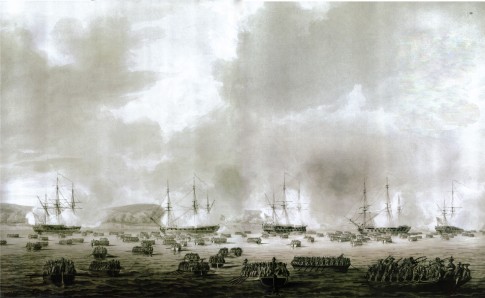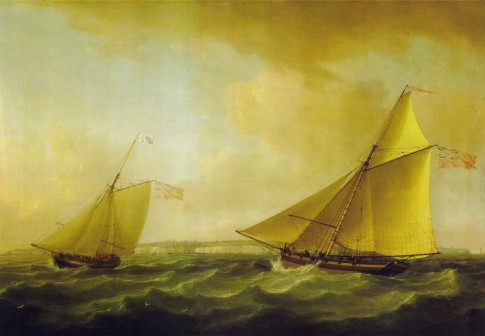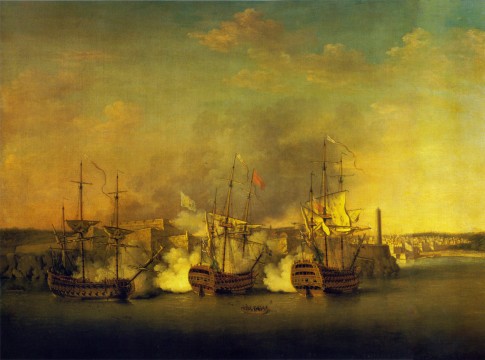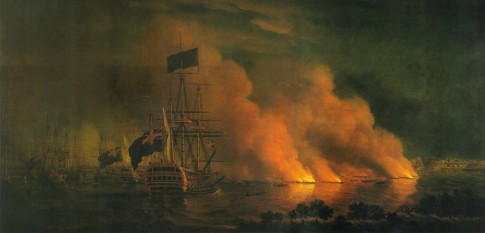In this largely imaginary view of Leghorn, where tall ships tower over a quay, an elegant lady on a white horse is about to depart. Three figures, gesturing theatrically, are also conversing or haggling over business. On the quay is a statue of Ferdinand I de’ Medici, who made Leghorn a free port. The monument, which still stands, was completed between 1595 and 1626 by Giovanni Bandini and Pietro Tacca, and became a symbol of the city.
Italianate Harbour Scene with the Monument of Ferdinand I de’ Medici at Leghorn
The Occupation of Newport, 9 December 1776
THE OCCUPATION OF NEWPORT, 9 DECEMBER 1776
By Robert Cleveley, 1777
(Highest resolution available 8165×5030)
In 1775 the 13 British colonies in North America rebelled against British rule and formally proclaimed their independence as the United States of America. What started as a war for America soon became a war for global maritime predominance. It differed in a number of significant factors from the Seven Years War, however. Firstly, Spain allied with France in 1779 and their combined navies were larger than that of the British. Secondly, the maritime war was conducted in Americas, thousands miles away from any quality dockyard resources. The Royal Navy’s successes in the Western Approaches in the Seven Years War had been largely achieved through easy access to the high-quality dockyards of the south and southwest coast of Britain. Crucially these had dry docks where the ships’ bottoms could be maintained and cleaned. In the coming war, however, that advantage was lost. Moreover, the War of American Independence came after nearly a decade of peace. In peacetime the ships had been laid up and the sailors and officers laid off, but to practise naval warfare at a high level required constant practice. Efficient sail handling and gunnery required crews to be drilled regularly; maneuvering the fleet required months of practice of each captain was to be able to regulate his position in relation to others be eye; and the repair pf damage caused by enemy fire or the weather was another skill that could be learned in dock. With no explicit and detailed policy to maintain operational effectiveness, rustiness had grown in Britain as quickly as complacency. The French and Spanish, meanwhile, had been steadily growing and modernizing their navies. In the coming war the Royal Navy was to receive a terrible shock.
THE OCCUPATION OF NEWPORT, 9 DECEMBER 1776. (Fragment)
When the war came, the Royal Navy used its experience in successful amphibious assaults of the previous war, among others, Québec and Havana to attack the rebels in their heartland. New York was a rebel stronghold and the most important commercial center in North America. To provide and alternative naval base to New York, Newport, Rhode Island, was also targeted, and the landing is shown in this image. The artist, Robert Cleveley, was an eyewitness to the assault, serving as captain’s clerk aboard the Asia. Both the attacks on New York and Rhode Island were great successes. The ships in the background can be seen laying down a covering bombardment while the boats pull for the beach. The boats in this image were specially designed landing craft known as ‘flatboats’. They could be stacked on board troopships, and once assembled and launched they could carry two rows of troops facing inward down the center, or artillery as is shown in the foreground to the right.
Between the Seven Years War and the American Revolution
The hostilities of the Seven Years War were ended in 1763 by the Treaty of Paris. This involved a complex series of land exchanges but it was quite clear that Britain had won an astounding victory through her successful use of sea power: Canada and India were now British colonies. Much had been learned by both sides during the war about the difficulties of maintaining and operating fleets of fighting ships and, crucially, about the defense of the British Isles from invasion. By 1763 invasion was a significant part of French strategy for almost 20 years. Although the English Channel is at its narrowest point only 21 miles wide, significant logistical factors worked against the French. To start with, there were no major French ports anywhere along the Channel. The nearest port that could hold an invasion fleet and the necessary warships to protect it was at Brest, facing the Atlantic on the western coast of Brittany. To launch an invasion across the Channel, the cumbersome and unarmed invasion craft would either have to make the journey alone, unprotected from strong British forces awaiting them on sea and land, or would have to wait for fleet of warships to escort them across. It was, however, exceptionally dangerous for a fleet of French warships to enter the Channel. Not only there were no French ports safe from the weather or from English attack, but escape from the Channel back towards Brest could not be guaranteed in the face of prevailing westerly winds.
For that reason a British squadron watching the Western Approaches to the Channel could protect Britain from invasion and, in the same time, both protect her own trade and attack that of the French. Thus was born the Western Squadron which was to prove highly effective in maintaining a permanent and close blockade of the French coast. The relentlessness of that blockade was made possible by significant administrative and logistical developments; not least the revictualling of the fleet at sea which allowed ships to stay on station, with healthy crews, indefinitely. This close blockade of the French ports not only countered the invasion threat but also squeezed the life out of the French navy and of the entire French war effort. Sailors were denied sea time; the port was denied stores; and the French war machine in turn was denied money as the private financiers who kept the French economy afloat were crippled by British success against French trade.
Maintaining the blockade forged a generation of officers and men who had learned their trade in the unforgiving conditions of the Bay of Biscay and in the harsh reality of combat. Moreover, the execution of Admiral Byng for failing to do his duty at the Battle of Minorca in 1756 strengthened the professional resolve of naval officers so that, at the Battle of Quiberon Bay in 1759, Hawke was able to demonstrate what was possible if healthy, dedicated and skilled sailors were well led.
Great technological breakthroughs had also been made. Of these the most significant was the emergence of the 74-gun ship as the backbone of every nation’s fleet. The 74 was large enough and had a significant weight of broadside to lie in the line of the battle alongside 100-gun ships of three decks, but she was also quick and maneuverable; a perfect compromise between the handiness of a frigate and the strength of a line of battle ship. Little progress was made regarding fleet tactics, however. Quiberon Bay had been a resounding success but the battle had been a chaotic melee, fought in a chase, and the French had not expected or desired battle. A number of actions had been fought in India in which both fleets had sought battle, but they again had proved indecisive affairs with both fleets fighting in parallel line ahead. The line of battle, like trench warfare, was far stronger in defense than attack and as yet no fleet was prepared to take the risks necessary to break it.
A Trinity House Yacht and a Revenue Service Cutter off Ramsgate
A TRINITY HOUSE YACHT AND A REVENUE SERVICE CUTTER OFF RAMSGATE
By Thomas Whitcombe, c.1810
(Highest resolution available 5914×4103)
The decade of peace between the Seven Years War and the beginning of the War of American Independence saw a greater focus on domestic maritime problems, chief among which was smuggling. The long-established national taste for expensive wars imposed a financial burden which fell largely on the public. They were faced with heavy taxes on a bewildering array of goods, both exported and imported, and this led directly, quickly and inevitably to an explosion in smuggling. In wartime smugglers flourished with few men of ships to spare to guard the coasts, but during the peacetime everything changed. After the Seven Years War the Revenue Service expanded dramatically in both number and size of its ships. The vessel on the right is an armed revenue cutter. By 1773 there were 29 such vessels in service, and by the end of the War of American Independence there were 42, employing over 1000 men. Armed cutters were designed and built specifically to counter the threat of the smugglers. Fast and handy, they were built with shallow draughts which allowed them to penetrate deep inland.
While the Revenue Service was responsible for the security of Britain’s borders, Trinity House was responsible for their safety. The lighthouses, lightships and navigational marker buoys around the English coasts were all owned and run by Trinity House. The vessel on the left is a Trinity House yacht.
Harrison’s H4 Chronometer, 1760
HARRISON’S H4 CHRONOMETER, 1760
(Highest resolution available 2010×2442)
While concerns about repairing and supplying ships remained permanent for all navies, the end of the Seven Years War saw a technological breakthrough that freed mariners from shackles that had bound them since man first learnt to navigate: the problem of longitude was solved. Mariners had been able to fix their latitude fairly accurately from the end of the 17th century using the quadrant and later the sextant to measure the elevation of the sun or pole star.
To fix their longitude, however, remained a problem, and it rested on the ability to tell the time accurately at sea. It may seem surprising that this was not possible, but clocks themselves were relatively new inventions, and to produce one that maintained its accuracy for long periods of time despite the motion of the ship, in humid and dry weather, and in hot and cold temperatures, was beyond everyone. Everyone, that is, except a young man called John Harrison, who from the age of 12 had kept a watch under his pillow to study its motion and listed to its tick. Harrison had been working on the problem of longitude for 34 years and had produced a number of solutions of varying quality (and enormous size), but in 1760 he produced his masterpiece, the H4. The portrait shows two of his previous inventions behind him, and the H4 in his hand. The H4 was almost frictionless and in a trial set up by the Admiralty it lost only 5.1 seconds in an 81 day voyage to Jamaica. For the first time ever, mariners could find out with a fair degree of certainty exactly where they were.
JOHN HARRISON
By Thomas King, 1767
(Highest resolution available 4068×5055)
The Improved Chain Pump
THE IMPROVED CHAIN PUMP
By John Bentinck
(Highest resolution available 1824×2700)
The withdrawal of the Cambridge, Marlborough and Dragon from their attack on the Morro Castle in Havana throws into sharp relief the difficulties of waging war far from significant dockyard resources and in the tropics where wood and iron decay quickly. The ships were able to continue their assault but were considered too damaged to be risked further. Much of the damage to the rigging and hull of a warship could be repaired anywhere in the world. Essentially organic, warships in this era were made almost entirely of wood, canvas, iron and hemp, and with plenty of spare material on board, new masts and yards could be fashioned from old’ split lines could be knotted and spliced; and holes in the sails and hull could be patched. But this self sustainability only went so far. Pumps like the one illustrated were extremely effective and could discharge as much as a ton of water per minute, but holes beneath the waterline were hard to find and even harder to mend permanently without access to dockyard or careening facilities. A leaking ship could also have a terrible effect on morale. On numerous occasions officers kept the true state of a sinking ship from their men to prevent panic from taking hold.
The Bentinck chain pump is an excellent example of British technological superiority over her rivals. No other navy had anything comparable.
Bombardment of the Morro Castle, 1 July 1762
BOMBARDMENT ON THE MORRO CASTLE, 1 JULY 1762
By Richard Paton, mid-18th century
(Highest resolution available 4500×3340)
In 1761 Spain entered the war, and Britain immediately planned operations against her colonies. An amphibious assault on Havana, the most significant Spanish settlement in the Americas, with a naval base, a dockyard producing quality ships made of tropical hardwood and a permanent squadron of warships, was settled upon. Havana was a formidable target defended by the Morro Castle, and three British warships, the 80-gun Cambridge, the 70-gun Marlborough and the 74-gun Dragon were sent to attack it in an action shown in this painting. Currents near shore always run fast and to attack a static, heavily defended shore battery from the unpredictable and shifting element of the sea was always difficult. On this occasion the guns of the Morro Castle were well manned and well aimed and the British ships were badly mauled and forced to retreat. A further attack had been landed upstream of the castle. The walls were breached and the castle taken by storm, but not before time. Thousands of British sailors and soldiers died from tropical disease. At the close of the war Havana was restored to Spain, but in return the island of Minorca, so crucial to British interests and so easily thrown away by Byng at the start of the war, was returned to Britain.
French Fire Rafts Attacking the English Fleet off Québec, 28 June 1759
FRENCH FIRE RAFTS ATTACKING THE ENGLISH FLEET OFF QUÉBEC, 28 JUNE 1759
By Samuel Scott, 1767
(Highest resolution available 6342×3048)
Only two days after the British force arrived, the French launched a fireship attack in a concerted effort to drive the enemy ships away before they could land the army, but Admiral Saunders was forewarned and prepared. His ships’ boats were manned and the fireships were towed to safety before they could inflict any damage. Wolfe’s troops were soon landed and, after a hazardous operation, in which both Wolfe and the French general the Marquis de Montcalm, died, Québec fell. Within a year Canada was in British hands.
James Cook’s Chart of the St Lawrence to Québec by Order of Vice Admiral Charles Saunders 1759
JAMES COOK’S CHART OF THE ST LAWRENCE TO QUÉBEC BY ORDER OF VICE ADMIRAL CHARLES SAUNDERS 1759, fragment above, full chart below
Published by Thomas Jefferys
(Highest resolution available 5640×973)
While the British were enjoying significant success in European waters, the war in Canada had also taken a significant turn. Assaults on French Montréal and Québec were both planned and crucial to the success of both was the navigation of a huge British fleet transporting Major General James Wolfe’s land forces up the St Lawrence River. This was quite a challenge: the navy had no charts of the St Lawrence, which is protected by a number of navigational hazards, and the French in Québec felt quite safe. Aboard the frigate Mercury however was a talented young navigator with an interest in hydrographic surveying named James Cook. In a short time he and a number of other officers had produced a sufficiently accurate and detailed chart of the St Lawrence to allow the entire fleet far enough upriver for Wolfe’s army to be landed to attack Québec. It was the start of a glittering career for the young Cook.
The Capture of the Foudroyant by HMS Monmouth, 28 February 1758
THE CAPTURE OF THE FOUDROYANT BY HMS MONMOUTH, 28 FEBRUARY 1758
By Francis Swaine, mid-18th century
(Highest resolution available 6480×5046)
Hawke’s victory was all the more remarkable because he attacked as night fell. Night-time actions were exceptionally dangerous. It was difficult enough to maneuver fleets of ships without collision in daylight and in calm weather, but at night and in a storm it was all but impossible. Ships would hang lanterns in their rigging and off the stern, but distance remained almost impossible to judge. It is not insignificant that, just prior to the Battle of Quiberon Bay, a squadron of British ships attacked and captured the Foudroyant at night, the subject of this painting. British seamanship had reached a level where night-time attack was possible. The officers were sufficiently confident in their own seamanship and perhaps more importantly, in the seamanship of their colleagues, to risk such an attack. Because it was a risky tactic it was unexpected, and because it was unexpected it was particularly effective.
To help officers see at night, ‘night telescopes’ had been invented but the earliest models had a significant flaw. In normal daytime telescopes additional lenses flipped the inverted image the right way round. However, these led to a loss of light and were removed from night telescopes with the result that at night the captain might be able to see his enemy from a long way off, but the image would be upside down.
Social Network

Feeds
18th Century, Battle Scenes, French Navy, Royal Navy, and Seven Years War| M | T | W | T | F | S | S |
|---|---|---|---|---|---|---|
| 1 | 2 | 3 | 4 | 5 | 6 | 7 |
| 8 | 9 | 10 | 11 | 12 | 13 | 14 |
| 15 | 16 | 17 | 18 | 19 | 20 | 21 |
| 22 | 23 | 24 | 25 | 26 | 27 | 28 |
| 29 | 30 | 31 | ||||
Recent Entries
- When the Sea Was Home: A Day Off Aboard HMS Clio
- When Legends Crossed Paths: A Look at Anthony D. Blake’s Maritime Masterpiece
- Dutch Ships in Distress off a Rocky Coast, Ludolph Backhuysen, 1667
- The Raid on Chatham (Raid on Medway), 17-23 June 1667
- Bombardment of Algiers by Anglo-Dutch Forces on August 26-27, 1816
- Battle of Livorno (Leghorn), March 14 1653
- Unsuccessful English attack on the VOC fleet at Bergen, 12 August 1665
- An English Ship with Sails Loosened Firing a Gun, by Peter Monamy
- Two Engravings by Ludolf Bakhuizen
- Boats in a Harbour and a Yacht Sailing Away by Willem van de Velde the Younger
Recent Comments
- Mellyism in The Bombardment of Algiers 27 Augus…
- Gazza in Bombardment of Algiers by Anglo-Dut…
- plpace in The Occupation of Newport, 9 Decemb…
- pete25t in The Bombardment of Algiers 27 Augus…
- vandentraak in The Dutch Fleet under Sail
- carolbmiller1 in Dutch Whalers off a Rocky Coast
- carolbmiller1 in The Dutch Fleet under Sail
- ray hammond in Battle of Texel (Slag bij Kijkduin)…
- andrew.pawley in The surrender of Prince Royal at th…
- don langvand in Two Engravings by Ludolf Bakhuizen
Categories
-
- 17th Century
- 18th Century
- 19th Century
- Battle Scenes
- Drawings
- Dutch Navy
- First Anglo-Dutch War
- French Navy
- French Revolutionary War
- Harbors
- Ludolf Backhuysen
- Portraits
- Royal Navy
- Russian Navy
- Second Anglo-Dutch War (1664–67)
- Seven Years War
- Third Anglo-Dutch War
- Uncategorized
- Unidentified Paintings
- War of American Independence
- Willem van de Velde the Elder
- Willem van de Velde the Younger











